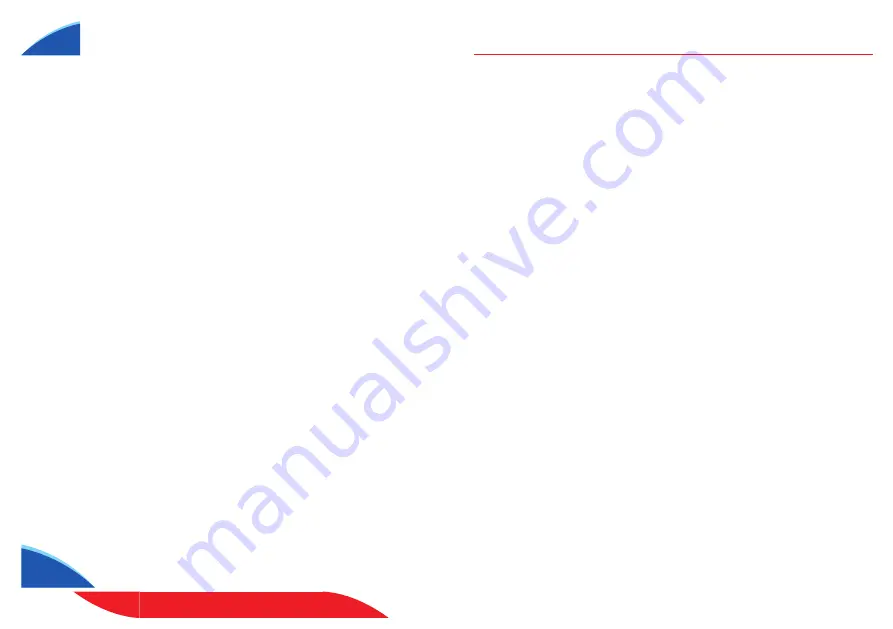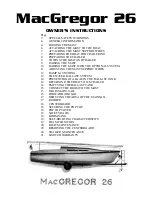
p. 20
Owners Manual
Abeam
– A relative bearing at right angles to the
centerline of the boat’s keel.
Aboard
– On or in a vessel.
Aft
– Towards the stern (of the vessel).
Aground
– Resting on or touching the ground or bottom.
Ashore
– On the beach, shore or land.
Astern
– towards the stern (rear) of a vessel.
Beam
– The width of a vessel at the widest point.
Bearing
– The horizontal direction of a line of sight
between two objects on the surface of the earth.
Bilge
– The compartment at the bottom of the hull of
a boat.
Bimini top
– Open-front canvas top for the cockpit of a
boat, usually supported by a metal frame.
Bollard
– A substantial vertical pillar to which lines may
be made fast.
Bow
– The front of a boat.
Bulkhead
– An upright wall within the hull of a boat.
Buoy
– A floating object of defined shape and color,
which is anchored at a given position and serves as an
aid to navigation.
Cabin
– an enclosed room on a deck or flat.
Chine
– A line formed where the sides of a boat meet the
bottom. Soft chine is when the two sides join at a shallow
angle, and hard chine is when they join at a steep angle.
Cleat
– A stationary device used to secure a rope aboard
a vessel.
Cuddy
– A small cabin in a boat.
Displacement
– The weight of water displaced
by the immersed volume of a boat’s hull.
Draft or draught
– The depth of a boat’s keel below the
waterline.
Fathom
– A unit of length equal to 6 feet (1.8 m), roughly
measured as the distance between a man’s outstretched
hands. Particularly used to measure depth.
Fender
– An air or foam filled bumper used in boating to
keep boats from banging into docks or each other.
Fixed propeller
– A propeller mounted on a rigid shaft
protruding from the hull of a vessel, usually driven by an
inboard motor; steering must be done using a rudder.
Freeboard
– The height of a boat’s hull (excluding
superstructure) above the waterline. The vertical
distance from the current waterline to the lowest point
on the highest continuous watertight deck. This usually
varies from one part to another.
Gunwale
– Upper edge of the hull.
Hatchway, hatch
– A covered opening in a boat’s deck
through which cargo can be loaded or access made to
a lower deck; the cover to the opening is called a hatch.
Head
– The toilet or latrine of a vessel, which in sailing
boats projected from the bows
Helm
– the wheel and/or wheelhouse area.
Hitch
– A knot used to tie a rope or line to a fixed object.
Also see bend.
Hull
– The shell and framework of the basic flotation-
oriented part of a boat.
Keel
– The central structural basis of the hull
Knot
– A unit of speed: 1 nautical mile (1.8520 km; 1.1508
mi) per hour.
Lanyard
– A rope that ties something off.
Lee side
– The side of a boat sheltered from the wind
Length overall, LOA
– the length of a boat.
Moor
– to attach a boat to a mooring buoy or post.
Outboard motor
– A motor mounted externally on the
transom of a small boat.
Port
– Towards the left-hand side of the boat facing
forward. Denoted with a red light at night.
Porthole or port
– an opening in a boat’s side, esp. a
round one for admitting light and air, fitted with thick
glass and, often, a hinged metal cover, a window
Running gear
– The propellers, shafts, struts and related
parts of a motorboat.
Stanchion
– vertical post near a deck’s edge that
supports life-lines.
Starboard
– Towards the right-hand side of a vessel
facing forward. Denoted with a green light at night.
Stern
– The rear part of a boat.
Sterndrive
– A propeller drive system similar to the lower
part of an outboard motor extending below the hull of
a larger power boat or yacht, but driven by an engine
mounted within the hull.
Transom
– a more or less flat surface across the stern of
a vessel. Dinghies tend to have almost vertical transoms,
whereas yachts’ transoms may be raked forward or aft.
Trim
– Relationship of boat’s hull to waterline.
V-hull
– The shape of a boat or boat in which the
contours of the hull come in a straight line to the keel.
Wake
– Turbulence behind a vessel.
Wash
– The waves created by a vessel. Not to be confused
with wake.
Windward
– In the direction that the wind is coming
from.
Yaw
– A vessel’s rotational motion about the vertical axis,
causing the fore and aft ends to swing from side to side
repetitively.
NAUTICAL TERMS



































